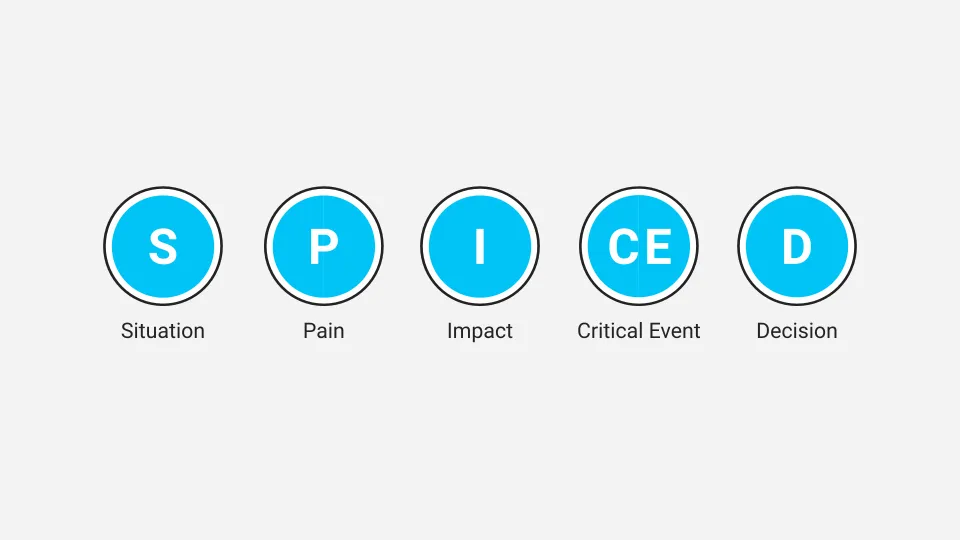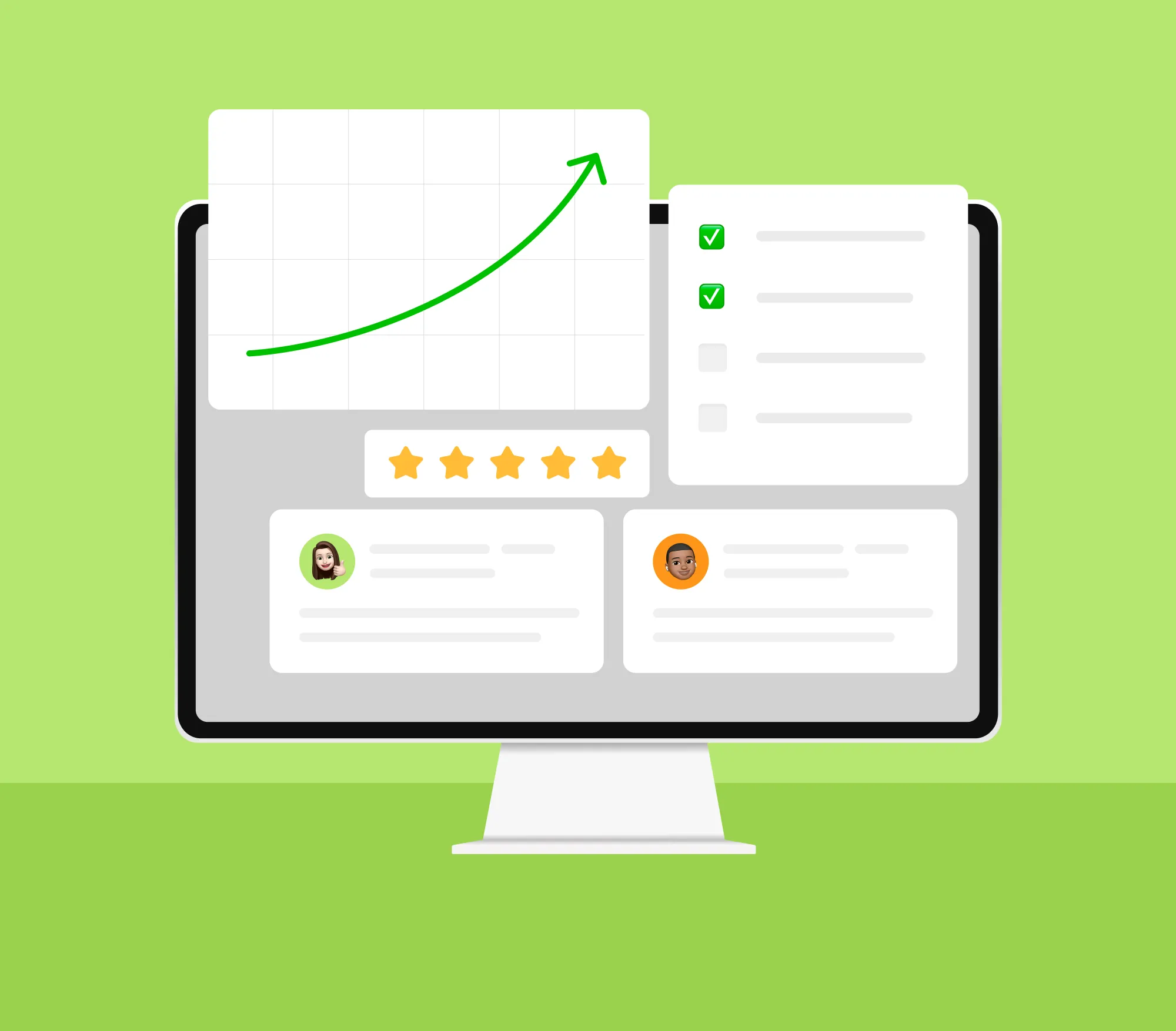Introduction to the SPICED Model

What is the SPICED Model in Sales
The SPICED model is a strategic framework used by sales teams to enhance their effectiveness throughout the sales process. It focuses on a series of key steps designed to align closely with the customer's needs and decision-making process, ultimately facilitating a more efficient and successful sales cycle.
Components of the SPICED Model
Situation
This first step involves understanding the customer's current state and the business environment.
Sales teams conduct thorough research and discovery calls to gather detailed background information about the customer's industry, market position, and internal challenges.
This knowledge helps tailor the sales approach to the specific circumstances and needs of the customer.
Pain Points
Identifying the customer's specific challenges or problems.
Through meaningful conversations and active listening, sales reps uncover the qualitative and quantitative pain affecting the customer.
Addressing these pain points directly in the sales strategy ensures the proposed solution is relevant and compelling.
Impact
Assessing how these pain points affect the customer’s operations or profitability.
Sales professionals use data and case studies to illustrate the potential consequences of inaction and the positive outcomes of addressing these issues.
Demonstrating the impact helps justify the investment in the proposed solution and accelerates the decision-making process.
Critical Event
Identifying any triggers or deadlines that may prompt the customer to act.
The sales team stays alert to external factors such as regulatory changes or market shifts that could influence the customer's urgency.
Understanding the timing can help prioritize sales efforts and customize the sales pitch to meet the immediate needs of the customer.
Decision
Detailing the decision-making process and criteria used by the customer.
Sales reps engage with various stakeholders to understand their roles and influence within the customer's decision-making process. This often involves presentations to decision-makers and adjusting the sales strategy based on their feedback.
Tailoring the approach to fit the decision criteria and stakeholders’ expectations increases the likelihood of a successful sale.
Why Implement the SPICED Model?
1. Improved Sales Methodology
The SPICED model provides a structured approach to sales, making it easier for teams to execute a consistent and effective strategy.
Implementing the SPICED model has been shown to increase sales productivity by up to 30% in organizations by streamlining the sales cycle and focusing efforts where they are most likely to yield results.
2. Improved Customer Acquisition and Retention
By focusing on the critical aspects of the customer's situation and needs, sales teams can better serve and retain their clients.
Businesses using the SPICED framework often report a 25% increase in customer retention rates due to more personalized and timely solutions.
3. Scalable Sales Processes
The SPICED model facilitates a uniform operating model that can be scaled across different teams and regions, ensuring consistency and quality in customer interactions.
Companies that standardize their sales process using frameworks like SPICED can reduce the length of their sales cycles by an average of 15-20%.
How to Close More Sales with SPICED Model

The SPICED Model is a systematic approach that guides sales teams through a detailed and methodical process to increase efficiency and close rates in sales. It focuses on understanding and leveraging key aspects of the customer's situation, pains, impact, critical events, and decision-making processes.
1. Situation
Grasping the situation helps in identifying how your product or service can fit into the customer’s existing setup and address specific challenges they face.
Examples:
- B2B Software Sales: Suppose you're selling a project management tool. In this case, you would gather information about the customer's current project management processes, tools they are using, team size, and the nature of projects handled.
- Healthcare Equipment Sales: If you're in medical device sales, knowing the hospital's or clinic's size, type of services offered, patient load, and current equipment setup is crucial.
How to Leverage: Use the situation analysis to build rapport and show genuine interest in the customer's environment. This sets a foundation for trust and positions you as a consultant rather than just a vendor.
2. Pain
Understanding the pain points allows you to tailor your sales pitch to highlight the benefits and features of your product that directly address the customer’s difficulties.
Examples:
- B2B Software Sales: If the customer's team is struggling with coordination and missing deadlines, the pain point might be inefficient project management tools or processes.
- Healthcare Equipment Sales: A clinic might be facing high patient wait times and staff frustration due to outdated diagnostic equipment.
How to Leverage: Emphasize how your solution specifically relieves these pains. For instance, demonstrate how your project management tool can streamline workflows, enhance communication, and improve deadline adherence. Or, in the case of the healthcare equipment, explain how newer, faster diagnostic tools can reduce patient wait times and increase throughput.
3. Impact
Identifying the impact helps quantify or elucidate the significance of the pain points, providing a compelling case for why the customer should act to resolve these issues. It essentially highlights the cost of inaction.
Examples:
- B2B Software Sales: If the customer is struggling with inefficient project management, the impact might include missed project deadlines, resulting in financial penalties or lost revenue, and strained client relationships.
- Healthcare Equipment Sales: Inefficiencies caused by outdated equipment might lead to longer patient wait times, decreased patient satisfaction, and potentially a lower patient return rate, impacting the clinic’s reputation and revenue.
How to Leverage: Discuss the specific impacts in a way that resonates with the customer's priorities. Quantify the benefits of solving the problem, such as cost savings, revenue increase, customer satisfaction improvements, or risk mitigation. This makes your proposition more persuasive.
4. Critical Event
Understanding the critical event helps tailor your sales pitch to meet the customer's timeline, making your solution not just desirable, but necessary within a specific timeframe.
Examples:
- B2B Software Sales: The customer may need to implement a new software solution before the start of their next fiscal quarter to ensure compliance with new industry standards.
- Healthcare Equipment Sales: A clinic might be preparing for a healthcare accreditation process and needs to upgrade their equipment to meet the new standards by a particular deadline.
How to Leverage: Frame your solution in terms of how it can specifically address the timing needs associated with the critical event. Highlight the ease of implementation, the support and training you offer, and any other factors that will help meet the urgent need.
5. Decision
Understanding the Decision process helps in crafting a sales strategy that aligns with how decisions are made within the customer's organization. It ensures that all the necessary influencers and decision-makers are engaged and that the sales pitch addresses their specific concerns and criteria.
Examples:
- B2B Software Sales: The decision process might involve multiple stakeholders, including IT managers, project managers, and financial officers. Each may have different concerns, such as the software’s compatibility with existing systems, its impact on project efficiency, and the return on investment.
- Healthcare Equipment Sales: Decision-making might primarily involve senior medical staff and hospital administrators. Factors influencing their decisions could include the equipment's reliability, the improvement in patient care, regulatory compliance, and cost-effectiveness.
How to Leverage: To navigate the Decision process effectively:
- Identify Key Stakeholders: Determine who is involved in the decision-making process and what their roles are. Ensure that your sales efforts address the needs and concerns of each stakeholder.
- Understand Decision Criteria: Find out what factors are most important to the decision-makers. This might involve financial considerations, operational efficiency, or compliance with industry standards.
- Align Your Pitch: Tailor your communications to address the specific criteria and concerns of the stakeholders. Highlight how your product or service meets these needs better than the competition.
- Facilitate the Process: Provide all necessary documentation, data, and trial opportunities to help stakeholders evaluate your offering. Be proactive in addressing questions and concerns.
Key Strategies to Maximize the SPICED Model's Effectiveness in Sales Process
Tailored Communication: Adapt your communication strategy to match the language and business culture of the customer.
- Example: If dealing with a technical team, focus on the specifications and efficiency gains; for executive boards, highlight strategic benefits and ROI.
Ongoing Relationship Management: Use the SPICED model to not only close deals but also build lasting relationships.
- Implement customer success teams to provide ongoing support and ensure the customer achieves the desired outcomes promised during the sales process. Regularly check in to address new pain points and refine solutions.
Data-Driven Selling: Back your claims with robust data and real-world examples.
- Use metrics from existing customers who have seen success with your solution. Quantify the benefits in terms of increased productivity, reduced costs, or other relevant metrics.
- Concrete data enhances credibility and reduces the perceived risk for the customer, facilitating a smoother decision-making process.
Impact of SPICED on Revenue

The SPICED methodology is not just a sales framework; it's a tool that impacts revenue by optimizing the customer journey and enhancing the effectiveness of sales teams. By applying SPICED, companies can see significant improvements in their revenue streams, particularly in terms of increasing recurring revenue and enhancing the overall efficiency of sales operations.
1. Customer Acquisition
SPICED streamlines the sales process, enabling sales teams to close deals more efficiently.
By focusing on the critical aspects of the customer's situation and addressing not just the symptoms but the root causes of their challenges, sales teams can tailor their pitches more effectively. This approach reduces the sales cycle duration and increases the conversion rate.
Companies report a 15-25% increase in conversion rates after implementing SPICED, directly boosting revenue.
2. Increase in Recurring Revenue by Customer Success Teams
The structured nature of the SPICED methodology helps in nurturing long-term relationships with clients.
Through consistent follow-ups and by continuously addressing evolving customer needs, SPICED ensures that solutions remain aligned with client goals, promoting customer satisfaction and retention.
Organizations have seen a 20-30% increase in recurring revenue from revenue teams due to improved customer retention rates.
3. Increased Deal Size
Leveraging the Impact component of the SPICED model helps sales teams demonstrate the value of their solutions in quantifiable terms.
Sales teams provide detailed analysis and data showing how their solutions can significantly improve operational efficiency or reduce costs for the customer.
Demonstrating the direct financial benefits of a solution encourages customers to invest in more comprehensive solutions, increasing the average deal size.
4. Faster Sales Cycles
Identifying Critical Events within the customer’s environment allows sales teams to time their sales pitches more effectively.
Sales representatives focus on upcoming regulatory changes, financial year-ends, or other events that create urgency for the customer.
When solutions are positioned to address immediate, time-sensitive needs, decisions are expedited, resulting in faster sales cycles and quicker revenue realization.
5. Scalability Across Markets
The adaptability of the SPICED methodology allows it to be applied successfully across various markets and industries.
By understanding and adapting to different market dynamics and customer behaviors, SPICED helps businesses tailor their sales approaches to meet diverse customer needs effectively.
This scalability leads to broader market penetration and can increase market share by 5-15%, depending on the industry.
Tools for the SPICED Sales Framework

The SPICED Sales Framework is a sales technique designed to help sales professionals effectively engage with potential customers by addressing their needs and concerns systematically.
Here’s how different tools can be utilized at each stage of this framework, integrating elements of sales strategy consulting:
1. Situation Tools
- CRM Software: Tools like Salesforce or HubSpot CRM can help sales managers gather and manage information about a client’s current situation. This includes details about the organization, industry, and any previous interactions with the company.
- Market Intelligence Tools: Platforms like Marketo or Clearbit provide data and analytics that can help salespeople understand the broader market context of their clients’ businesses.
2. Problem Tools
- Survey Tools: Using survey tools such as SurveyMonkey or Google Forms to gather data directly from potential customers about their pain points.
- Customer Feedback Platforms: Tools like Uservoice or GetFeedback can help sales reps collect and analyze customer feedback, pinpointing specific problems that need addressing.
3. Impact Tools
- Data Analysis Tools: Software like Microsoft Excel or Tableau can be used to analyze data and show potential impacts of problems quantitatively. This can include forecasting potential revenue loss or efficiency decrements.
- Presentation Software: Tools such as Microsoft PowerPoint or Prezi can help create compelling presentations that outline the negative impacts of unresolved problems to the stakeholders.
4. Critical Event Tools
- Project Management Tools: Applications like Asana or Trello can help in planning the steps needed to navigate critical events or deadlines.
- Calendar Scheduling Tools: Tools such as Calendly or Google Calendar facilitate scheduling meetings or demos that align with critical events in the customer’s timeline.
5. Economic Benefit Tools
- ROI Calculation Tools: Custom spreadsheets or specialized software like ROI calculators (often proprietary tools provided by companies) can be used to articulate the economic benefits of a solution.
- Business Intelligence Tools: BI tools like SAP Business Objects or IBM Cognos can help in creating detailed business cases that highlight potential economic benefits.
6. Decision Tools
- Electronic Signature Software: Tools like DocuSign or Adobe Sign streamline the final agreement process, making it easier and faster for clients to make decisions and sign contracts.
- Decision Support Systems (DSS): Advanced software that helps in analyzing complex options and forecasts outcomes to aid in decision-making processes.
Concluding Thoughts on SPICED Customer Success Model
In conclusion, the SPICED Model is an effective and structured framework that can significantly enhance the sales process. By methodically addressing each phase — from understanding the customer's current situation to navigating their decision-making process — this model helps sales teams craft tailored strategies that resonate with potential clients.
Whether you're a sales manager looking to improve your team's performance or involved in sales strategy consulting, implementing the SPICED Model can lead to more closed deals, increased customer satisfaction, and ultimately, higher revenue. By leveraging the appropriate tools at each stage, sales teams can streamline their operations, making the sales process not only faster but also more effective.
Further Reading
To deepen your understanding of sales strategies and continue refining your sales process, we recommend exploring the following resources. These articles provide valuable insights and practical tips to further enhance your sales team's effectiveness:
- Mastering Lead Generation Strategies: A Step-by-Step Guide: Learn the art of lead generation with this detailed guide. It covers essential tactics and strategies that will help you attract and convert more prospects effectively. Read more.
- What is Performance Marketing and How Can It Boost Sales?: Dive into the world of performance marketing to understand how it can optimize your sales efforts. This article explains the fundamentals and benefits of performance marketing in driving sales success. Read more.
- Email Marketing Essentials: How to Market with Email: Discover the keys to successful email marketing. This resource offers practical advice on creating compelling email campaigns that engage your audience and drive conversions. Read more.
- The Recurring Revenue Model: Why It's Vital for Sustainability: Understand the importance of establishing a recurring revenue model for long-term business success. This article explains the benefits and strategies for implementing this model in your business. Read more.
- Understanding the Difference Between Sales and Marketing: Explore the critical differences between sales and marketing and why recognizing these distinctions is essential for effective business strategy. This resource sheds light on how aligning both functions can enhance overall performance. Read more.
These resources offer comprehensive guides and strategies to refine every aspect of your sales process, from initial prospecting to closing deals. Delve into these articles to build on the foundations of your chosen sales methodology and drive sustained success for your sales team.





.jpg)

.jpg)
